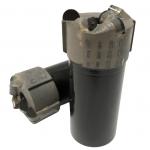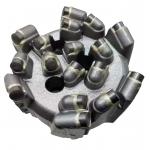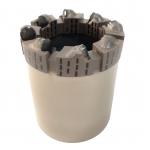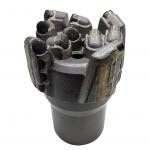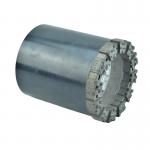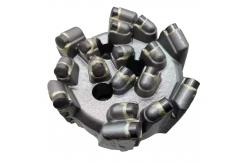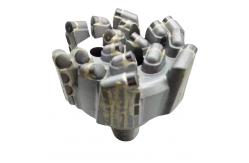Reduced Bit Whirl Enhanced Drilling Performance in Fractured
Reservoirs PDC Drill Bit some additional details on drilling and PDC (Polycrystalline
Diamond Compact) drill bits: PDC Bit Formation Compatibility: PDC drill bits are designed to be
compatible with specific types of formations based on their
characteristics. Different formations have varying hardness,
abrasiveness, and drilling challenges. PDC bits are engineered with
specific cutter configurations, cutter materials, and hydraulics to
optimize drilling performance in specific formations. For example,
bits designed for soft formations may have more closely spaced
cutters, while bits for hard formations may have larger cutters
with increased durability. PDC Bit Stability: Maintaining stability during drilling operations
is crucial for efficient and safe drilling. PDC bits are designed
with features to promote stability, such as gauge pads or
stabilizers. Gauge pads are positioned on the outer edge of the bit
to control the bit's diameter and prevent it from deviating from
the desired wellbore trajectory. Stabilizers, either integral or
separate, can be added above or below the bit to enhance axial
stability and reduce vibrations. PDC Bit Steerability: In directional drilling applications where
precise wellbore trajectories are required, PDC bits can be
designed with steerability features. These bits incorporate
technologies such as asymmetric cutter layouts or mechanical
devices that allow controlled steering of the bit. Steerable PDC
bits enable operators to navigate through complex subsurface
formations, reach specific targets, and optimize well placement. PDC Bit Run-in and Break-in Procedures: When a new PDC bit is
deployed, it undergoes run-in and break-in procedures to optimize
its performance and longevity. During the run-in process, the bit
is initially operated at reduced weight on bit (WOB) and rotational
speed to gradually introduce it to the drilling environment.
Break-in procedures involve gradually increasing the WOB and
rotational speed to achieve full drilling parameters. These
procedures help minimize the risk of bit damage and ensure proper
bit seating and stabilization. PDC Bit Design Optimization Software: Advanced software tools are
available to aid in the optimization of PDC bit design. These
software programs use data inputs such as formation
characteristics, drilling parameters, and desired performance
objectives to generate optimized bit designs. The software utilizes
algorithms and simulations to analyze various design options and
predict their performance. This optimization process helps identify
the best bit design for specific drilling conditions, improving
drilling efficiency and reducing non-productive time. PDC Bit Failure Analysis: In the event of PDC bit failure or
suboptimal performance, failure analysis techniques can be employed
to identify the root cause and prevent future issues. Failure
analysis involves examining the bit, cutters, and other components
to determine the failure mechanism, such as cutter wear, cutter
breakage, or bit body failure. This analysis helps in understanding
the limitations of the bit, improving future designs, and
implementing preventive measures. PDC Bit Compatibility with Other Drilling Technologies: PDC bits
can be used in conjunction with other drilling technologies to
optimize drilling efficiency and achieve specific objectives. For
example, PDC bits can be combined with rotary steerable systems
(RSS) or mud motors for enhanced directional drilling performance.
PDC bits can also be integrated with measurement-while-drilling
(MWD) or logging-while-drilling (LWD) tools to provide real-time
formation evaluation data during drilling operations. PDC Bit International Standards: International organizations and
associations, such as the American Petroleum Institute (API) and
the International Association of Drilling Contractors (IADC), have
established standards and guidelines for PDC drill bits. These
standards cover aspects such as bit design specifications,
performance metrics, testing procedures, and quality control.
Compliance with these standards ensures consistency, reliability,
and interoperability of PDC bits across the industry. PDC Bit Innovations for Specific Applications: PDC bit
manufacturers continuously develop specialized designs to address
specific drilling challenges and improve performance in particular
applications. For example, PDC bits designed for geothermal
drilling may incorporate features to withstand high-temperature
environments and resist chemical reactions. Similarly, PDC bits
used in mining applications may have enhanced durability to
withstand abrasive formations and extended drilling campaigns. PDC Bit Industry Trends: The drilling industry is influenced by
evolving trends that shape the development and use of PDC drill
bits. Some notable trends include the increasing demand for
automation and digitalization in drilling operations, the adoption
of data-driven decision-making through advanced analytics, the
focus on environmental sustainability and reduced carbon footprint,
and the exploration of unconventional resources that require
specialized bit designs and technologies.
These additional details provide further insights into various
aspects of PDC drill bits, their applications, optimization, and
industry trends. As drilling technology advances and new challenges
emerge, ongoing research and development efforts continue to drive
innovations in PDC bit design and performance. FAQ: 1. Q: Can PDC bits be used for drilling in andesite formations?
A: PDC bits can be used for drilling in andesite formations.
However, cutter selection and bit design should consider the
hardness and abrasive nature of andesite 2. Q: Can PDC bits be used for drilling in conglomerate formations?
A: PDC bits can be used for drilling in conglomerate formations.
However, designs with enhanced cutter protection may be required to
handle the challenges posed by the presence of cobbles and pebbles. 3. Q: Can PDC bits be used for drilling in limestone with shale
partings formations?
A: PDC bits can be used for drilling in limestone with shale
partings formations. However, designs that address the presence of
shale partings and provide efficient cuttings removal are
important. 4. Q: Can PDC bits be used for drilling in altered and fractured
granite formations?
A: PDC bits can be used for drilling in altered and fractured
granite formations. However, cutter selection and bit design should
consider the presence of altered minerals and fractures. 5. Q: Can PDC bits be used for drilling in siltstone formations?
A: PDC bits can be used for drilling in siltstone formations.
However, designs that prevent bit balling and ensure efficient
cuttings removal are crucial. 6. Q: Can PDC bits be used for drilling in limestone with oolitic
texture formations?
A: PDC bits can be used for drilling in limestone with oolitic
texture formations. However, designs that address the presence of
hard oolitic grains and prevent bit damage are important. |
